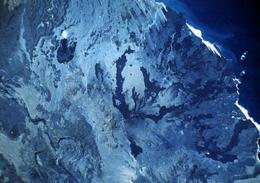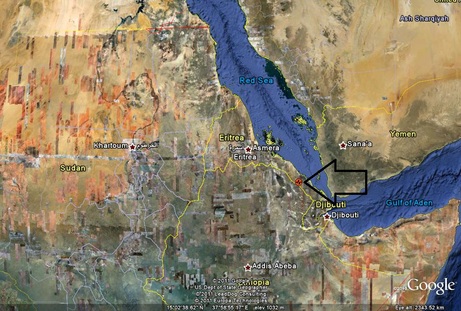|
NEWER UPDATE AVAILABLE: It seems I was premature in assuming the eruption was from Dubbi. The eruption is now believed to have originated from Nabro. I have left this post here as it is still an interesting overview of Dubbi and volcanism in the area. An eruption of the Dubbi volcano, which is located in Eritrea, has started after a series of strong earthquakes were detected and has spread an ash cloud ~1000 km from the summit. The eruption is believed to have started at 21:00 UTC on the 12th June. For full information on the eruption visit the Volcanism Blog for more information. Here I am going to give a brief overview of Dubbi Volcano, its past eruptions and why volcanism is seen here.  Dubbi from the GVP, black lava flows can be seen. Dubbi is a stratovolcano at ~1625 m high. It has known several previous eruptions of which ones in 1400 and 1861 are confirmed. Further eruptions in 1863 and 1900 remain unconfirmed. When dubbi erupts it has produced both an explosive eruption at the source vent and lava flows which can be seen trending off towards the see in the photo on the right. At the summit of Dubbi are a number of scoria cones according to John Seach. Dubbi generally produces effusive basaltic volcanism after a more explosive stage involving rhyolitic products - this was the case in 1861. In 1861 the eruption began in an explosive ash producing manner, with pumice and highly mobile pyroclastic flows produced which stretched to ~25 km from the volcano. After this stage, the eruption became more effusive with a series of scoria cones produced and lava flows which stretched up to 22 km from the source area were also quite thick ~20 m in most places. Overall this eruption produced ~3.5 km3 of magma, meaning that it is the largest eruption of an African volcano in historical times.Please read Wiart and Oppenhiemer for more detailed info on this eruption. Geologically it's position is extrememly interesting, Dubbi is located at the Afar triple junction, where the Arabian, Somalian and African plate are interacting. There is also a mantle plume (or hot spot) in the Afar triangle area. Dubbi is in the southern part of the Afar trianle and is part of the East African Great Rift Valley. The volcanism at Dubbi is probably associated with the spreading of the plates at the centre of the red sea. The Afar triangle is more famous for the active lava lakes of the Erta Ale Volcano. Sources
John Seach Wiart and Oppenheimer, 2000. Largest known historical eruption in Africa: Dubbi volcano, Eritrea, 1861 Geology 28, p. 291-294 9/2/2013 06:17:54 am
I am preparing a research paper and collecting information on this topic. Your post is one of the better that I have read. Thank you for putting this information into one post. Comments are closed.
|
Archives
July 2023
|



 RSS Feed
RSS Feed